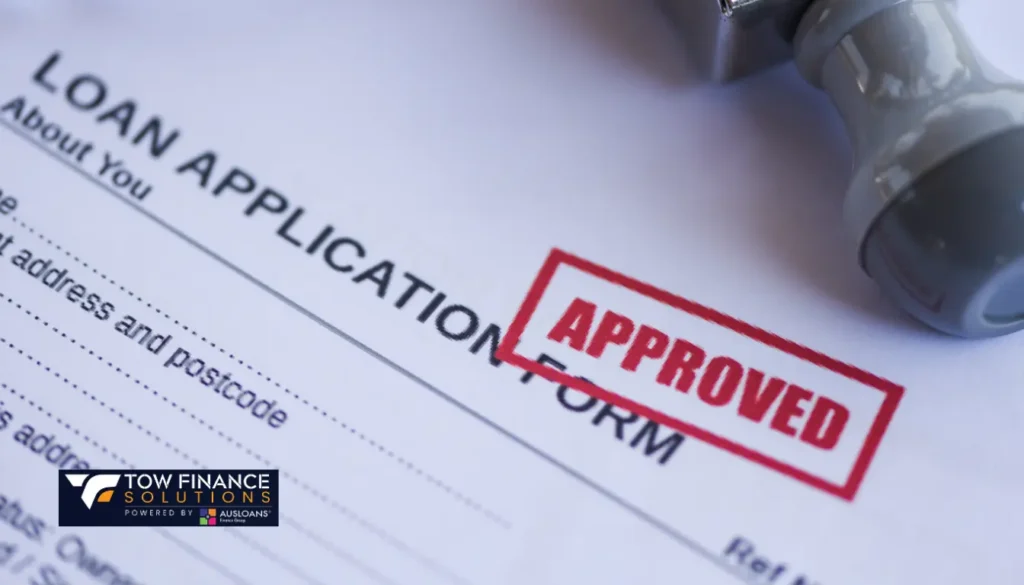The Role of Guarantors in Car and Business Loans
A Complete Guide to Secured Financing
Sept 18, 2025
When traditional loan approval seems out of reach, guarantors can be the bridge to securing the vehicle or business financing you need. At Tow Finance Solutions, we understand that every customer’s situation is unique, and sometimes having a guarantor can make the difference between loan approval and rejection. With our network of over 40 lenders and commitment to fast approvals, we help customers explore all available options, including guarantor-backed loans.
Whether you’re seeking car finance for your dream vehicle or business finance to grow your company, understanding the role of guarantors can open doors to better loan terms and faster approval times.
Overview
This comprehensive guide explores everything you need to know about guarantors in car and business loans. You’ll discover what guarantors are, their legal responsibilities, qualification requirements, and how they can help secure financing when traditional applications fall short. We’ll also examine the benefits and risks for both borrowers and guarantors, along with practical alternatives and expert tips for navigating the guarantor loan process.
Find The Best Deal

With over 10 years of industry experience we are a leading independent broker with a diverse panel of 40 + lenders to find you the best solution, tailored to you and your goals!
Key Takeaways
• Guarantors provide additional security for lenders by agreeing to repay loans if the primary borrower defaults
• Having a guarantor can improve loan approval chances and potentially secure better interest rates
• Guarantors must meet specific financial and legal requirements, including stable income and good credit history
• Both borrowers and guarantors should understand the legal obligations and potential risks involved
• Alternative financing options exist for those who cannot secure a guarantor
• Clear communication and legal documentation are essential for all parties involved
What Is a Guarantor and How Do They Work?
A guarantor is an individual who agrees to take legal responsibility for repaying a loan if the primary borrower fails to meet their repayment obligations. This arrangement provides lenders with additional security, reducing their risk when approving loans for borrowers who may not meet standard lending criteria on their own.
In car and business lending, guarantors serve as a safety net for lenders. When you apply for a car loan with a guarantor, the lender evaluates both your financial position and your guarantor’s ability to service the debt. This dual assessment often results in more favorable lending decisions.
The guarantor arrangement is particularly valuable for borrowers with limited credit history, recent credit difficulties, or insufficient income to qualify independently. By having someone with stronger financial credentials vouch for them, borrowers can access financing that might otherwise be unavailable.
How Guarantor Loans Work in Practice:
• The primary borrower applies for the loan and nominates a guarantor
• The lender assesses both parties’ financial circumstances
• If approved, both parties sign legal agreements outlining their responsibilities
• The borrower makes regular repayments as agreed
• The guarantor only becomes liable if the borrower defaults

Types of Guarantor Arrangements
Limited Guarantees
Limited guarantees are the most common form of guarantor arrangement in vehicle and business financing. Under this structure, the guarantor’s liability is capped at a specific amount, typically 20-100% of the loan value. This provides protection for guarantors while still giving lenders adequate security.
Limited guarantees often involve securing the guarantee against the guarantor’s property, such as their family home. However, the guarantee amount is usually much less than the property’s value, providing a buffer of equity protection.
Unlimited Guarantees
Unlimited guarantees place no cap on the guarantor’s liability, making them responsible for the full loan amount plus any associated costs, fees, and legal expenses if the borrower defaults. These arrangements are less common in consumer lending but may be used in certain business finance situations.
Security Guarantees
Security guarantees involve the guarantor providing an asset (usually property) as additional security for the loan. The lender can recover their losses by selling this asset if both the primary borrower and guarantor default on their obligations.
Key Differences Between Guarantee Types:
• Limited guarantees cap the guarantor’s exposure to a predetermined amount
• Unlimited guarantees make guarantors liable for all loan-related costs
• Security guarantees involve pledging assets as additional collateral
• Each type carries different risk levels for guarantors
Legal Responsibilities and Obligations of Guarantors
Being a guarantor involves significant legal responsibilities that extend beyond simply providing character references. Guarantors enter into binding legal contracts that can have serious financial consequences if not properly understood.
The primary legal obligation of a guarantor is to repay the loan if the borrower defaults. This responsibility typically includes the outstanding principal, accrued interest, fees, and legal costs associated with debt recovery. Guarantors should understand that their liability often continues even if the original loan terms change.
Guarantors also have ongoing obligations to maintain their financial capacity throughout the loan term. Significant changes in income, employment, or financial circumstances should be disclosed to the lender, as these may affect the guarantee’s validity.
Core Legal Responsibilities:
• Repay outstanding debt if the primary borrower defaults
• Maintain financial capacity to service the guaranteed amount
• Disclose material changes in financial circumstances
• Comply with all terms and conditions in the guarantee agreement
• Provide accurate financial information during the application process
Rights and Protections for Guarantors
Despite their obligations, guarantors have important legal rights and protections. These include the right to receive copies of all loan documents, regular statements showing the loan balance, and notification of any defaults or changes to loan terms.
Guarantors also have the right to seek independent legal advice before signing guarantee documents. Lenders are required to recommend this step, and guarantors should take advantage of this protection to fully understand their commitments.

Qualification Requirements for Guarantors
Lenders impose strict qualification criteria for guarantors to ensure they can fulfill their obligations if required. These requirements typically mirror or exceed the standards applied to primary borrowers, as guarantors must demonstrate their ability to service the guaranteed debt.
The most fundamental requirement is stable, verifiable income sufficient to service both the guarantor’s existing commitments and the guaranteed loan amount. Lenders typically require guarantors to earn at least 1.5 times their total debt service obligations, including the potential guarantee liability.
Credit history is another critical factor. Guarantors must have a clean credit record with no recent defaults, bankruptcies, or other serious credit impairments. Some lenders may accept minor credit issues if they’re satisfactorily explained and don’t indicate a pattern of financial difficulty.
Essential Guarantor Qualifications:
• Stable employment history (typically 2+ years in current role)
• Sufficient income to service all debt obligations plus the guarantee
• Clean credit history with no recent defaults or serious impairments
• Australian citizenship or permanent residency
• Minimum age requirement (usually 18+ and maximum age limits may apply)
• Property ownership or significant assets (for secured guarantees)
Relationship Requirements
Most lenders require guarantors to be family members or have close personal relationships with the borrower. This requirement reduces the risk of guarantors not understanding their obligations or being pressured into arrangements they don’t fully comprehend.
Acceptable guarantor relationships typically include parents, adult children, siblings, spouses, or de facto partners. Some lenders may accept close friends, but this is less common and usually requires additional documentation to prove the relationship’s nature and stability.
Benefits of Having a Guarantor
Having a guarantor can significantly improve your chances of loan approval and potentially secure more favorable loan terms. For borrowers with limited credit history or those who don’t quite meet standard lending criteria, guarantors can be the key to accessing necessary financing.
One of the most significant benefits is improved loan approval odds. When lenders assess applications with guarantors, they consider the combined financial strength of both parties. This often tips the scales in favor of approval for borderline applications that might otherwise be rejected.
Guarantors can also help secure better interest rates and loan terms. By reducing the lender’s risk, guarantor-backed loans may qualify for lower interest rates than unsecured alternatives. This can result in substantial savings over the loan term, making financing more affordable.
Key Benefits for Borrowers:
• Higher likelihood of loan approval
• Potential for better interest rates and terms
• Access to larger loan amounts
• Faster approval processes with reduced documentation requirements
• Opportunity to build or rebuild credit history through successful repayments
Benefits for Building Credit History
Successfully managing a guarantor-backed loan can help borrowers establish or improve their credit history. Regular, on-time payments demonstrate creditworthiness to future lenders, potentially eliminating the need for guarantors in subsequent loan applications.
This is particularly valuable for young people seeking their first car loan or business owners looking to establish commercial credit history. The guarantor arrangement provides a pathway to independent financing capability.
Risks and Considerations for Guarantors
While helping family members or friends secure financing can be rewarding, becoming a guarantor involves significant risks that must be carefully considered. The most obvious risk is financial liability if the borrower defaults, but there are other important considerations that potential guarantors should understand.
The primary risk is being required to repay the full guaranteed amount plus associated costs if the borrower defaults. This obligation can arise suddenly and may strain the guarantor’s finances, particularly if they weren’t adequately prepared for this possibility.
Guarantor obligations can also affect the guarantor’s own borrowing capacity. Lenders treat guarantees as potential debts when assessing applications for mortgages, personal loans, or other financing. This can limit the guarantor’s ability to access credit for their own needs.
Major Risks for Guarantors:
• Full financial liability if the borrower defaults
• Reduced personal borrowing capacity due to guarantee obligations
• Potential impact on credit history if defaults occur
• Stress and relationship damage if repayment problems arise
• Limited ability to exit the guarantee once signed
• Possible legal action by lenders for debt recovery
Relationship and Emotional Considerations
Money-related agreements can strain even close relationships. Guarantors should consider how potential repayment difficulties might affect their relationship with the borrower. Open communication about expectations, repayment plans, and contingencies is essential.
It’s also important to consider the long-term nature of guarantee obligations. Car loans typically run for 5-7 years, while business loans can extend much longer. Guarantors must be comfortable with this extended commitment and potential liability.
How Guarantors Can Improve Loan Terms
Beyond simply enabling loan approval, guarantors can help borrowers secure significantly better loan terms and conditions. This improvement stems from the reduced risk profile that guarantors create for lenders, often resulting in preferential treatment similar to that offered to the lender’s best customers.
Interest rate reductions are among the most valuable improvements guarantors can facilitate. Even a small reduction in interest rates can save thousands of dollars over the loan term. For example, reducing a car loan rate from 12% to 9% on a $40,000 loan could save over $3,000 in interest charges.
Loan-to-value ratios may also improve with guarantor backing. Lenders might approve higher percentages of vehicle value or business asset costs when guarantors are involved, reducing the required deposit or equity contribution from borrowers.
Loan Improvements with Guarantors:
• Lower interest rates due to reduced lender risk
• Higher loan-to-value ratios requiring smaller deposits
• Extended repayment terms for improved affordability
• Reduced or waived establishment fees and charges
• Faster processing and approval times
• Access to premium loan products typically reserved for low-risk borrowers

The Process of Adding a Guarantor to Your Loan Application
Adding a guarantor to your loan application involves several steps that must be carefully managed to ensure all parties understand their obligations and rights. At Tow Finance Solutions, we guide both borrowers and guarantors through this process, ensuring transparency and compliance with all legal requirements.
The process begins with identifying a suitable guarantor who meets the lender’s qualification criteria and is willing to accept the associated responsibilities. This person should understand both the immediate commitment and potential long-term implications of the guarantee arrangement.
Once a guarantor is identified, they must complete their own application process, including providing financial documentation, employment verification, and credit checks. This process runs parallel to the primary borrower’s application but may require additional time for completion.
Step-by-Step Guarantor Application Process:
- Identify and approach potential guarantor
- Explain the commitment and obtain preliminary agreement
- Complete guarantor application forms and documentation
- Undergo credit and financial assessment
- Attend independent legal advice session
- Review and sign guarantee documentation
- Finalize loan approval and settlement
Documentation and Legal Requirements
Proper documentation is crucial for guarantor arrangements. All parties must receive copies of loan agreements, guarantee documents, and disclosure statements. Guarantors are typically required to obtain independent legal advice before signing, ensuring they fully understand their commitments.
The legal advice process involves meeting with a qualified solicitor who explains the guarantee terms, potential liabilities, and the guarantor’s rights. This step protects both the guarantor and the lender by ensuring informed consent to the arrangement.
Alternatives to Guarantor Loans
While guarantor loans can be effective solutions, they’re not suitable for everyone. Alternative financing options exist for borrowers who cannot secure guarantors or prefer not to involve family and friends in their loan arrangements.
Secured loans using the financed asset as collateral are common alternatives. Car finance arrangements typically use the vehicle as security, reducing the need for additional guarantees. Similarly, business equipment finance uses the purchased equipment as collateral.
Building a stronger application through improved credit history, larger deposits, or co-borrower arrangements can also eliminate the need for guarantors. Taking time to strengthen your financial position before applying may result in better loan terms without the complications of guarantee arrangements.
Guarantor Loan Alternatives:
• Secured loans using purchased assets as collateral
• Joint applications with co-borrowers rather than guarantors
• Specialist lenders with flexible criteria
• Bad credit car loans with higher interest rates but no guarantor requirements
• Lease arrangements for business equipment • Vendor finance from vehicle dealers or equipment suppliers
Building Credit Without Guarantors
For borrowers with limited credit history, starting with smaller, unsecured loans and demonstrating reliable repayment behavior can build creditworthiness over time. This approach takes longer but avoids the complications and relationships risks associated with guarantors.
Credit building strategies include obtaining secured credit cards, making all payments on time, reducing existing debt levels, and maintaining stable employment. These steps can improve credit scores and loan eligibility within 12-24 months.
Choosing the Right Lender for Guarantor Loans
Not all lenders offer guarantor loan products, and those that do have varying criteria and processes. Selecting the right lender is crucial for securing favorable terms and ensuring a smooth application process for all parties involved.
At Tow Finance Solutions, our network of over 40 lenders includes multiple options for guarantor-backed loans. This diversity allows us to match borrowers and guarantors with lenders whose criteria best suit their specific circumstances, improving approval odds and terms.
When evaluating lenders, consider their guarantor policies, interest rates, fees, and processing times. Some lenders specialize in guarantor arrangements and offer streamlined processes, while others may treat them as special cases requiring additional scrutiny and time.
Factors to Consider When Choosing Guarantor Loan Lenders:
• Experience and expertise with guarantor arrangements
• Competitive interest rates and fee structures
• Clear, transparent guarantee terms and conditions
• Efficient processing and approval times
• Strong customer service and support throughout the loan term
• Flexibility in guarantee structures and requirements
Working with Finance Brokers
Finance brokers like Tow Finance Solutions offer significant advantages when seeking guarantor loans. Our expertise in lender criteria and product features helps match applications with the most suitable lenders, improving approval chances and terms.
Brokers also provide valuable guidance throughout the application process, ensuring all parties understand their obligations and rights. This support is particularly important in complex arrangements involving guarantors, where multiple parties must coordinate their involvement.
Common Mistakes to Avoid
Guarantor loan arrangements can become problematic if not properly structured and understood. Common mistakes can result in legal difficulties, relationship damage, and financial hardship for all parties involved.
One of the most frequent mistakes is insufficient communication between borrowers and guarantors about expectations and contingency plans. Both parties should discuss what happens if repayment difficulties arise, including how they’ll handle temporary financial stress or more serious default situations.
Failing to obtain independent legal advice is another critical error. While lenders typically recommend this step, some guarantors skip it to save time or money. This shortcut can result in unexpected liabilities and limited options if problems arise later.
Common Guarantor Loan Mistakes:
• Insufficient communication about expectations and risks
• Skipping independent legal advice to save time or money
• Not understanding the guarantee terms and conditions
• Failing to review the borrower’s financial stability adequately
• Ignoring the impact on personal borrowing capacity
• Not having exit strategies if circumstances change
• Mixing family relationships with formal legal obligations without proper boundaries
Protecting Relationships
Money-related agreements can damage relationships if not properly managed. Clear agreements about communication, regular updates on loan status, and contingency plans help protect personal relationships while fulfilling financial obligations.
Setting boundaries about involvement in the borrower’s financial decisions and maintaining regular but non-intrusive communication can help preserve relationships throughout the loan term.
Tax Implications and Considerations
Guarantor arrangements can have tax implications that both borrowers and guarantors should understand before entering into these agreements. While guarantors don’t receive tax benefits from their guarantee provision, they may face tax consequences if they’re required to make payments on behalf of the borrower.
For business loan guarantors, payments made under guarantee obligations may be tax-deductible if they relate to income-producing activities. However, this depends on the specific circumstances and should be discussed with qualified tax advisors.
Borrowers should also understand how guarantor arrangements affect their own tax position, particularly for business loans where interest payments and guarantee fees may be deductible against business income.
Key Tax Considerations:
• Guarantor payments may not be immediately tax-deductible
• Business-related guarantee payments might qualify for deductions
• Borrowers may claim interest and fees as tax deductions for business loans
• Capital gains tax implications may apply if property is used as security
• Professional tax advice is recommended for complex arrangements
When to Consider Releasing a Guarantor
Guarantee arrangements don’t have to continue for the entire loan term. Many lenders allow guarantor release once the borrower demonstrates improved creditworthiness or the loan balance reduces to acceptable levels.
Typical release triggers include the borrower maintaining perfect repayment history for 12-24 months, loan balance reducing below 80% of security value, or significant improvement in the borrower’s income or credit profile.
Common Guarantor Release Criteria:
• Perfect repayment history for specified periods
• Loan-to-value ratio improvement through payments or asset appreciation
• Borrower income increase or credit score improvement
• Reduction in other debts improving debt-to-income ratios
• Completion of probationary employment periods
Frequently Asked Questions
What happens if I can’t find a suitable guarantor for my loan? If you can’t secure a guarantor, explore alternative options such as secured loans, joint applications with co-borrowers, or specialized lenders with flexible criteria. Our team at Tow Finance Solutions can help identify suitable alternatives from our network of 40+ lenders.
Can guarantors limit their liability to a specific amount? Yes, many guarantee arrangements include liability caps limiting the guarantor’s exposure to predetermined amounts. Limited guarantees are common and provide protection for guarantors while still giving lenders adequate security.
What documentation do guarantors need to provide? Guarantors typically need to provide income statements, employment verification, bank statements, asset documentation, and undergo credit checks. The specific requirements vary by lender but generally mirror those required of primary borrowers.
Can guarantors withdraw from the arrangement after signing? Once signed, guarantee agreements are legally binding and cannot be easily withdrawn. However, some lenders allow guarantor release under specific circumstances, such as improved borrower creditworthiness or reduced loan balances.
How does being a guarantor affect my own borrowing capacity? Lenders treat guarantee obligations as potential debts when assessing your borrowing capacity. This can reduce your ability to obtain additional credit, as lenders must consider your ability to service both your own debts and the guaranteed amount.
What happens to the guarantee if the borrower sells the financed asset? Guarantee obligations typically continue even if the financed asset is sold, unless the loan is completely repaid from the sale proceeds. The guarantee terms should specify what happens in various scenarios, including asset disposal.
Can business partners be guarantors for each other’s loans? Yes, business partners can act as guarantors for each other, but this creates complex cross-guarantee situations that require careful legal structuring. Professional advice is essential to manage the risks and obligations properly.
What legal protections exist for guarantors? Guarantors have rights including access to loan documents, regular statements, default notifications, and the right to independent legal advice. Consumer protection laws also provide safeguards against unfair contract terms.
How long do guarantee obligations typically last? Guarantee obligations usually continue for the entire loan term unless specific release conditions are met. For car loans, this is typically 5-7 years, while business loan guarantees may extend for much longer periods.
Can guarantors negotiate better terms for the borrower? Guarantors with strong financial profiles can help borrowers secure better interest rates, loan amounts, and terms. Their involvement reduces lender risk, often resulting in preferential treatment for the entire loan package.
Get Expert Guidance on Guarantor Loans Today
Understanding guarantor loans can be complex, but you don’t have to navigate this process alone. At Tow Finance Solutions, our experienced team helps both borrowers and guarantors understand their options, obligations, and opportunities. With access to over 40 lenders and a commitment to fast, transparent service, we’re here to help you secure the right financing solution.
Whether you’re considering a guarantor for your car finance needs or exploring business loan options, our experts can guide you through every step of the process. Contact us today at (07) 4410 3375 or visit our contact page to discuss your specific situation and discover how we can help you achieve your financing goals.
Sources
- Australian Securities and Investments Commission (ASIC) – Guarantor Rights and Responsibilities
- Australian Competition and Consumer Commission (ACCC) – Consumer Credit Protection
- Australian Prudential Regulation Authority (APRA) – Lending Standards
- Reserve Bank of Australia – Household Finance Statistics
- Australian Banking Association – Industry Code of Practice
- Financial Rights Legal Centre – Guarantor Obligations Guide







